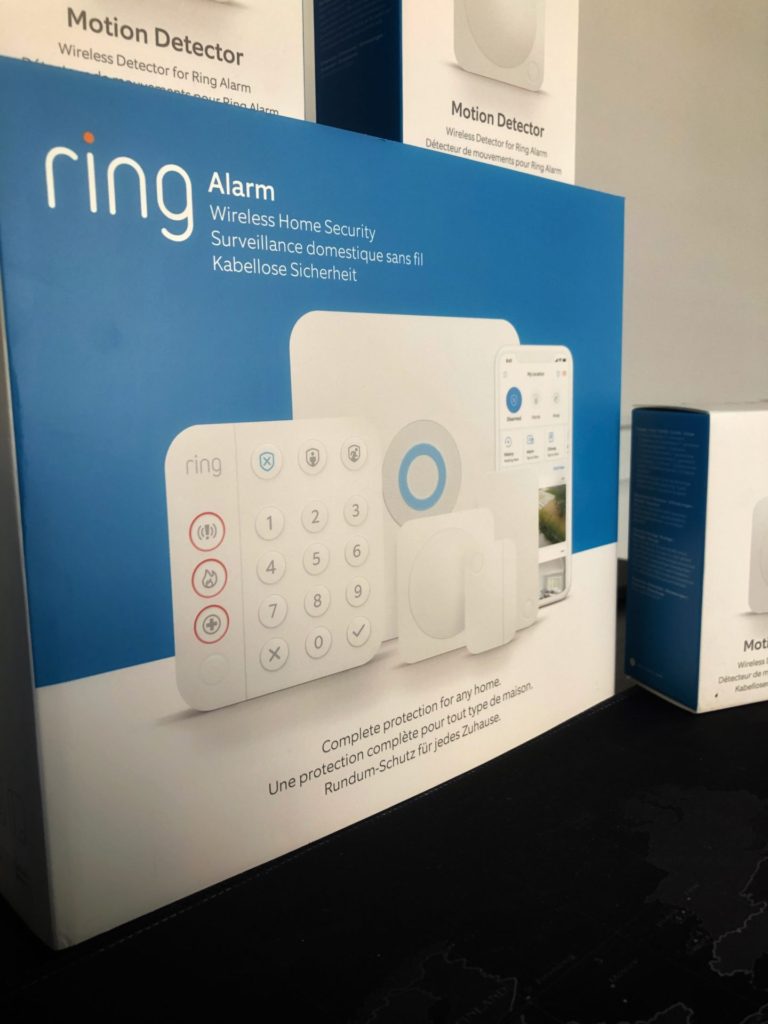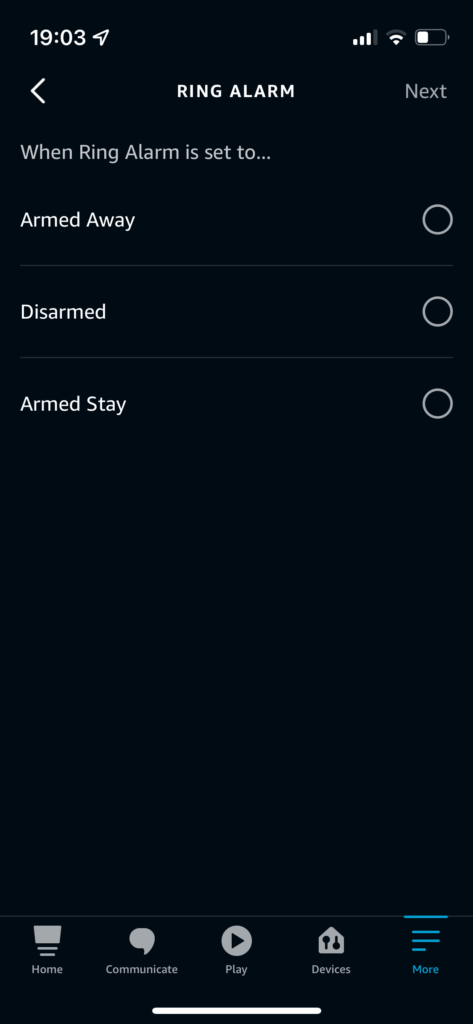Ring Alarm 2nd Gen Review
Intro
The Ring Alarm system is a popular DIY smart alarm. You will have heard of Ring, the home security company owned by Amazon, who are mostly known for their video doorbells but are also big players in the smart alarm market. I got my hands on the 2nd generation of their smart alarm system to protect my home and here are my thoughts on the system.
SHOULD YOU BUY IT?
Pros
- DIY Setup
- Simple to Use
- Affordable
Cons
- Lack of Alexa Integration Features

Ring Alarm 2nd Generation Starter Kits

The Ring Alarm 2nd Gen can be purchased as either a starter kit that comes with all the components needed to get started or you can buy everything separately. If this is your first Ring Alarm system then the starter kits are the best value for money. This was my first Ring Alarm system so I got the 7 piece starter kit which included a base station, keypad, range extender, 2 motion sensors and 2 contact sensors. Now I wanted more motion sensors than that to cover my home so I also bought 4 more of those. I think most homes would need more than 2 motion sensors to cover their house so Ring could do with including a few more in their starter kits. Price-wise the system is pretty competitive. At the time of writing the 7 piece kit is £239 on Amazon. See links to the different kits on Amazon below.
How to Set Up Ring Alarm System
Base Station

Installing the Ring Alarm 2nd Gen could not be any easier in my opinion. To get started with installation you download the ring app from your respective app store. From there the app walks you through exactly what to do and it is super easy. Firstly you activate the base station which is the brain of the system. All the devices connect to the base station which uses Z-Wave to communicate with all the sensors and the keypad. The base station also acts as a siren when the alarm is triggered. It is plugged into a wall socket but does feature a 24-hour backup battery in case you have a power cut. To connect the base station to the internet you can use ethernet or Wi-Fi, with ethernet being the most reliable of the 2.
Keypad

After you have linked the base station to the app it walks you through adding the additional components. The backlit keypad is rechargeable and comes supplied with a charging cable so you can feed it constant power if you have a power outlet close to where you plan to install it. If you want it to use the battery, don’t worry, it slides off the backplate so you can plug it in to charge it. It does have a healthy 6 month estimated battery life so you won’t be charging it all that often anyway.

The Ring Alarm 2nd Gen keypad is smaller than the 1st Gen keypad measuring in at 149 x 100 x 23mm making it more versatile when it comes to installation locations. When considering installation, the keypad doesn’t have to be wall-mounted, you can prop them up on surfaces also which makes the Ring Alarm 2nd Gen system suitable for renters as well. I opted for the wall mounting option in my hallway but you could also look to use 3m adhesive as well to fix it to the wall but adhesive strips aren’t included with the keypad.
Sensors

Finally, you link the sensors to the base station. Again installation of these is very versatile. Each sensor comes with 2, 3m adhesive strips on the back to stick them to the wall but also has space in the backplate for screw fixings. Like the keypad, the sensors feature a QR code on the rear of the device which you can scan to easily pair the device to the base station. The motion sensors run off 2x AA batteries whereas the smaller contact sensors run off 2x CR2032 batteries. Changing these batteries is very simple as you can slide both sensors off their backplates, switch the batteries out and then slide them back on. Both sensors feature a reduced size over the 1st gen editions with the contact sensor measuring 400 x 530 x 140mm and the motion sensor coming in at 66 x 66 x 36mm. Once all these devices have been configured you are ready to start monitoring your home.
Additional Devices
You can also link the range extender if you are experiencing poor signal strength. I have not experienced these issues so I haven’t linked the range extender that came with the kit but it is there just in case.
Ring also offers a separate outdoor siren as well. This is a great offering by Ring and I will definitely be looking to get one of those to add to my setup.
Features & How it Works
Once you have set up your devices it’s time to configure the Ring Alarm system. The Ring Alarm 2nd Gen has 3 configured alarm modes for you to customise, Disarmed, Home and Away. I look at the 3 modes like this;
Contact and motion sensors can be configured to behave how you want in each of the three modes. This enables you to fully customise how you monitor your home. For example, in the Home mode, you could have all your upstairs motion & contact sensors to not trigger the alarm in case you get up in the night and need to move around your landing or upstairs. All of this is configured in the Ring app. When you click on an individual sensor there is a “Mode Settings” option, this is where you set it up.

An important feature of any alarm system is entry points and having a delay to give you time to enter your passcode and disarm the alarm. Without this, the alarm would just go off as soon as you returned home. Again this is really easy to setup in the Ring app. You can configure a contact and motion sensor as the main door and entrance sensors. This means that these sensors will start a countdown when they detect motion whilst armed to enable the alarm to be disarmed. You can customise this entry delay to 0, 30, 45, 60, 120 or 180 seconds. Similarly, you get the same options when setting the exit delay to give you time to leave the house before the alarm is triggered. Play around with these delays to find the time that works best for you.

The benefit of a smart alarm system, like the Ring Alarm, is that you get push notifications to your phone regarding the status of your home alarm. This is something you just cannot get with traditional alarm systems. It is really easy to check its status and if the alarm does go off it will notify you so you know what is going on. You also get the ability to arm and disarm your alarm via your phone or voice through Amazon Alexa. To be honest I rarely use the keypad to interact with the alarm because it is so easy to do it via the app. This gives that added flexibility that you only get with smart alarms.
One really cool feature of the Ring Alarm 2nd Gen is Geofencing. Geofencing allows you to add some element of automation to the setting and disarming of your alarm. If you leave your house without setting your alarm it can notify you that you have done so so you can arm it. When arriving home it can also snooze ring devices like cameras and doorbells if you have them so they don’t trigger unwanted alerts.

Another feature I really like is the ability to setup custom passcodes for guests and visitors. This feature allows you to setup time-limited passcodes that people can use to disarm and arm your Ring Alarm system. The benefits of this are that you don’t have to share your actual passcode with them. Once their code has expired it no longer works, preventing them from having the ability to interact with the alarm. really handy if you have trusted people entering your home whilst you are out.
How to Arm Ring Alarm
The great thing about a smart alarm system like the Ring Alarm 2nd generation is there is not just one way to arm the system. You can choose which ever method is most suitable for you personally. Not only can you arm the alarm via the keypad like a traditional alarm but you can also use the Ring app, your voice through Alexa or with geofencing. I personally use the Alexa echo dot in my bedroom to arm the alarm every night. It is just so convenient.
Doing it in the app is also really simple as you are greeted with the 3 system state buttons when you open it and well, the keypad is the keypad very familiar to most people what to do here.
How to Disarm Ring Alarm
Similar to arming the Ring Alarm 2nd generation you get a number of different way to also disarm it. The only difference here is that if you opt to use your voice to deactivate it then Alexa will ask you for a secret code as well. This does make sense for security reasons so anybody can’t use Alexa to bypass your homes security but it can slow down the disarm process. I personally use a combination of the Ring app and the keypad.
Ring Protect Plus
Self-monitoring is the standard and free method of monitoring with the Ring Alarm system. What this means is that any alerts or triggers of the alarm have to be handled by yourself. The authorities will not be notified of these events. The Ring Protect Plus plan is Ring’s option for a professionally monitored alarm system. In the event of the alarm being triggered the service will attempt to contact you or any of your set emergency contacts to determine if it is a genuine alarm or not. If they cannot get through to you or you tell them it is not a false alarm the emergency services will be dispatched to your house to investigate.
Another great feature of the Protect Plus plan, which I wish they included with self-monitoring, is cellular backup in the event your Wi-Fi goes down. This will make sure that your base station remains connected to the internet and continues to monitor. Now if your internet goes down and your alarm is triggered whilst you are self-monitoring the base station siren will still sound you just won’t get the push notification to your phone.

The Ring Protect Plus plan is £8 a month here in the UK. I did the 30-day free trial you get when you buy the system but have not renewed the subscription as of yet. Self-monitoring works for me at the moment. If the cellular backup feature was brought into self-monitoring I would 100% say the Protect Plus plan is not worth it. If you already have multiple Ring cameras then it is likely you may already have the Ring Protect Plus plan so this won’t be an issue.
Smart Home Integration
Being able to integrate your alarm into your smart home setup is another great reason to opt for a smart alarm system. With Ring being an Amazon company I was really excited to integrate their alarm into my Alexa smart home setup. Unfortunately, I was left a little bit disappointed here. The ability to arm the Ring Alarm via Alexa with your voice is a great feature and is something I use every night before going to bed. However, there is no functionality to trigger Alexa routines when the alarm changes state. For me, a great use of this would be to turn on smart lights around the home when the Ring Alarm 2nd Gen is triggered during set hours of the day. Unfortunately, though this is not possible currently, hopefully, this feature will be included at a later date though. The motion and contact sensors can be used to trigger Alexa routines and you can get creative with this. I have a routine that triggers a custom voice message on the bedroom echo dot if any of the downstairs motion sensors detect motion during set hours.
Unfortunately, there is still no way that I could find to set up the Ring alarm 2nd generation with Google Home. You can find articles online of people stating they have used IFTTT and other bridge platforms to connect the two but it’s just all a bit too messy to be honest. So the bottom line is if you are in the Google ecosystem get a different smart alarm.


Alexa Ring Alarm Commands
Here are a list of the most useful Alexa commands for the ring alarm.
- “Alexa, arm ring” – this will arm the system
- “Alexa, set ring to home mode” – this will set the system to the home mode
- “Alexa, set ring to away mode” – this will set the system to away mode
- “Alexa, is ring armed?” – this will tell you of the system is armed
- “Alexa, disarm ring” – this will disarm the system one the voice passcode has been provided
Final Thoughts
On the whole, I love this alarm system. Once you try a smart alarm system like the Ring Alarm 2nd Gen you will never go back to a traditional alarm. It actually makes home security kind of fun. For me, the only thing that lets the system down is the lack of Alexa integration. Surely this will be enhanced in future software updates but frustratingly it isn’t available currently.
Let me know what you think of the Ring Alarm 2nd Gen down in the comments below.
Thanks for reading this review.
Until next time![]()
*There are affiliate links in this post, so we may earn a small commission when you make a purchase through these links on our site at no additional cost to you.


